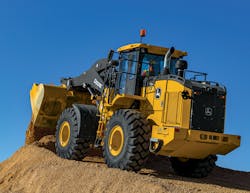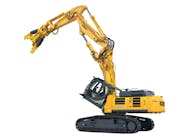Way down inside, you know that if you need to move or load materials such as soil, rock, sand, or demolition debris, these original equipment manufacturers are gonna give you their list of best wheel loaders, and, like Led Zeppelin, they’re not foolin’.
Wheel loaders, bucket loaders, front-end loaders, or just loaders—however you refer to them, these versatile construction machines come in a wide range of sizes to suit the application, such as site prep, road building, digging, and hauling materials.
A More Robust Deere
John Deere’s lineup of wheel loaders includes compact, utility, and production class sizes. “Historically, our most popular models coincide with the highest volume industry model size class,” says Luke Gribble, solutions marketing manager, Quarry & Aggregates/Ag Material Handling. That size class encompasses the John Deere 524, 544, and 624 models. They’re popular because they work well in a variety of applications.
The 524, 544, and 624 models are available in Standard Lift, High Lift, and High Lift Plus configurations, the latter of which provides an additional 24 inches in hinge-pin height over Standard Lift height and 12 inches over the High Lift model. The 524 and 624 can also be ordered in a new Tool Carrier configuration that enables a clear view of the coupler and forks, making it easier to move pipes, logs, and pallets quickly.
When Deere launched the L-Series loaders, they were known for their versatility, performance, and comfort. The recent availability of performance-tiered machines offers the same qualities. For example, EH controls are more intuitive to operate, compared with previous models, and expanded EH functionality allows specific attachment configuration settings, such as hydraulic flow and responsiveness, for up to 10 different attachments to be conveniently stored.
New bucket and linkage designs improve cutting, leveling, material retention, and visibility. Also, enhanced production buckets can be integrated with spill guards, curved side cutters, and greater rollback to deliver better bucket fill performance and material retention. “All these performance improvements lead to increasing productivity on any job site,” Gribble states.
For the operator, JD loaders offer an all-new, more ergonomic cab with three additional inches of legroom, a more robust HVAC system, additional storage, and a more adjustable seat. Premium cab upgrades include a larger monitor, Automatic Temperature Control that allows operators to self-adjust settings to maintain certain temperatures, and a heated and ventilated premium seat with heavy-duty suspension.
A safety feature is the optional dedicated rearview camera display along with a Radar Object Detection System to provide operator visibility to the rear of the machine while maintaining visibility to vital machine information on the primary monitor and audible alerts when approaching objects.
Updated Komatsu Model
The WA270-8 and WA320-8 are popular, proven, smaller models from Komatsu. “The WA470-8 has been one of our popular mid-size models for many years,” says Adam Braun, product marketing manager. He attributes its popularity to its versatility in many segments, pointing out that while many customers use it in construction and small quarry applications, others choose it for forestry, agriculture, municipal, landscaping, and waste applications. “We even have WA470-8s that operate at major international airports for snow removal during winter months.”
Komatsu recently released the WA475-10, a direct replacement for the WA470-8 in all those applications, but with improved productivity and efficiency as well as a lower cost of ownership that is partly due to fuel efficiency improvements of about 30% over the WA470-8. "It also provides expanded product versatility with the new optional Yard Loader configuration," Braun adds.
One of the primary reasons for the popularity of the WA270-8 and WA320-8 is that they are responsive, quick, and efficient all-purpose machines, according to Nathan Repp, product marketing manager. “They are really the right size loader for jobs that require transport speed and rapid cycle times, while providing lift capacity, reach, traction, and stability.”
But ease of operation doesn’t hurt their popularity. A hydrostatic transmission helps deliver high tractive effort to the ground in a way that allows the operator to get more done rapidly, Repp explains. “There are no gear ratio changes, so power delivery is smooth and linear. There is no drivetrain slippage with traction control, so no power is lost like [with] a conventional transmission.” That also extends tire life, just as dynamic braking extends wear and protects the brakes from heat.
Standard operator features like heated and air-suspended seat, mono-lever work controls, and custom flow control settings for the closed center load sense hydraulic system. Bluetooth radios for hands-free operation, anchor tie-off points, and front window access steps are new and included as standard equipment.
Customer feedback was incorporated in the design of the WA475-10. Its "centerpiece" of new technology is the Komatsu Hydraulic Mechanical Transmission, Braun says. "This new transmission divides the power from the engine into mechanical power (mechanical planetary transmission) and hydraulic power. This division results in the ease of operation of an HST with the efficiency of a mechanical transmission." The engine speed of the WA475-10 is maintained at a lower, more consistent RPM, which contributes to increased fuel efficiency (tons per gallon) by up to 30% and fuel savings (gallons per hour) up to 17%.
The WA475-10 features a completely redesigned operator’s cabin that offers a quiet and pressurized work environment with an ergonomic layout that places machine control switches on the right pillar within easy reach and at eye level so operators can focus forward. “Additional glass in the bottom of the cab, doors, and rear enhances visibility during operation,” Braun adds.
Another improvement on the WA475-10 is the patented, independent work equipment controls. Instead of using the accelerator pedal to control equipment speed, the operator controls speed by the position of the lever. This helps reduce both brake wear and operator fatigue.
Volvo Packages
Volvo models L70 (3-yard) and L90 (3.7-yard) encompass a popular size class for material handling, forestry, utility work, and snow removal, says Chris Connolly, product manager, medium loaders North America. With options to tailor them to the application, they can “do a lot of things,” he says. “There are lots of attachments—including custom attachments.”
There are also packages, such as Waste and Ag packages. “It’s easy to order a machine set up for the application,” Connolly indicates, comparing the badging for each application with trim levels in cars.
Other advantages Volvo machines offer include:
Ease of transport
Industry-leading fuel efficiency
Cab comforts such as seat options
Reverse and forward camera options
Larger camera view
Optional integrated radar system with visual and audio warnings when in reverse and near objects
Fluorescent orange three-point seat belts
Ground-level service points and handholds
High resale value
Cat
While he won’t say they’re Caterpillar’s most popular wheel loaders, Scott Schmidtgall, product application specialist, thinks the 966M XE, 972M XE, and 950GC models should be because they’re easy to operate and versatile. Features he highlights include:
Patented Performance Series Buckets for reduced fuel consumption and quick cycle times
Caterpillar Production Measurement payload scale integrated into machine systems for accuracy, reduced time, fuel, and cylinder wear due to the low lift weight and dynamic tip-off capabilities
APEX shifting strategy lock-up torque converters for smooth shifting
Eco mode maintains full first-gear rimpull and torque to load the bucket quickly
Variable ground speed limiter to limit max propulsion speeds from a safety perspective
The object detection system, a speed-sensitive radar-based system that alerts operators in the cabin both visually and audibly
Technology
Today’s customers expect machine monitoring, onboard diagnostics, and telematics, Repp believes. Komtrax from Komatsu monitors machine utilization, fuel consumption, working modes, and KDPF regeneration. It also generates e-mail notifications of important maintenance or service-related events.
Deere offers a five-year JDLink telematics subscription that provides machine location, utilization data, and alerts to help customers maximize productivity and efficiency. Alerts can be as basic as seat belt latch status if a loader is equipped with the seat belt minder monitoring system, which sends an alert to JDLink if the seat belt isn’t latched within 30 seconds of releasing the parking brake. “An optional green seat belt indicator beacon on the cab will illuminate when the seat belt is latched,” Gribble notes.
JDLink also enables John Deere Connected Support. John Deere’s centralized Machine Health Monitoring Center and specialists can monitor machine health and proactively address conditions to prevent or reduce downtime, Gribble says.
Volvo “doesn’t really offer machine control like in excavators because it’s not as popular on loaders,” Connolly says, although he predicts that the company “will eventually have machine control” because of the safety aspect. Meanwhile, the company does offer Co-pilot, a 10-inch Android-based in-cab “operator coach” that monitors the operator and makes suggestions for better machine performance. “It’s an answer to the operator shortage.”
Connolly recommends active guidance for operators unaccustomed to the buttons in the cab. “It’s a good review for new operators and those who haven’t been in the machine often enough to become familiar.”
In addition to providing “hints and guidelines” about how to operate the machine, Volvo Co-pilot has a map app that shows the location of all machines on a site, including non-Volvo machinery. “You can also add points of interest like buildings, gas stations, hazards…” Connolly lists.
Cat’s Schmidtgall agrees that machine control isn’t common on wheel loaders but says telematics can drive demand for machines and enhances resale because it documents on-time maintenance. When combined with onboard payload scales, Cat’s VisionLink combines tonnage with hours, location, and fuel usage for more valuable metrics.
They’re Asking For It
No matter how much technology or how many innovations are installed on a loader, customers will always want something more. “Contractors continue to ask for payload management systems, integrated telematics with enhanced diagnostics, productivity monitoring, ride control, traction control, and features that appeal to the new generation of operators joining the workforce,” Braun says.
Finding and keeping skilled operators is one of the top concerns in the construction industry. John Deere addresses this by having more features at the operator’s fingertips. “On the John Deere P-tier loaders, operators can easily control up to six functions without removing their hand from the ergonomically designed joystick,” Gribble explains.
For ease of operation at all skill levels, two industry-exclusive multifunction buttons can be programmed to handle any of the 10 functions selected through the monitor on a JD model. Some of the functions that can be programmed into the joysticks include soft or hard hydraulic stops, hydraulic function flow, bucket vibrate, and EH precision mode. The sealed switch module also has updated or new functions, including the return-to-dig setting that allows leveling of the bucket from both dump and curl positions, constant-flow hydraulics that allow the operator to continuously run attachments without having to hold a lever or roller at a full stop, and throttle lock that can maintain a specified rpm so the operator can warm up a machine, run a continuous flow attachment, or road the machine without having to hold the throttle pedal down.
To suit different operator styles, Volvo offers adjustable controls with the ability to switch between single and multi-controls, Connolly points out. This variable approach controls traction while loading for improved fuel usage and reduced tire wear. “The lock-up torque converter has a higher top speed for tracked vehicles and lower RPMs for better fuel mileage.”
Volvo’s long boom for high dump clearance set the standard, Connolly says. “Customers always ask for it.” That’s something customers want now, but Volvo is already looking to what they’ll be asking for in the future. “We recently launched compact electric machines. The industry is looking at electrical.”
Alternative fuels are getting attention because “the total cost of ownership is a huge focus,” Connolly comments. Software improvements to lower fuel usage are an ongoing quest. Computer control can lower wear on internal components, in part by changing the shift strategy to reduce friction. Such actions can extend service life and lower the cost of ownership.
Schmidtgall says most of Cat’s requests center on features that improve productivity, like their optional auto-dig feature to control most of the dig cycle, which can be helpful for novice operators, or augment safety, like their standard backup camera, integrated into the color touchscreen display so there is no need for an additional monitor in the cab.
The biggest demand is simply for equipment. Connolly observes that “the industry has dipped some this year,” but says there’s still a whole lotta’ work going on.














